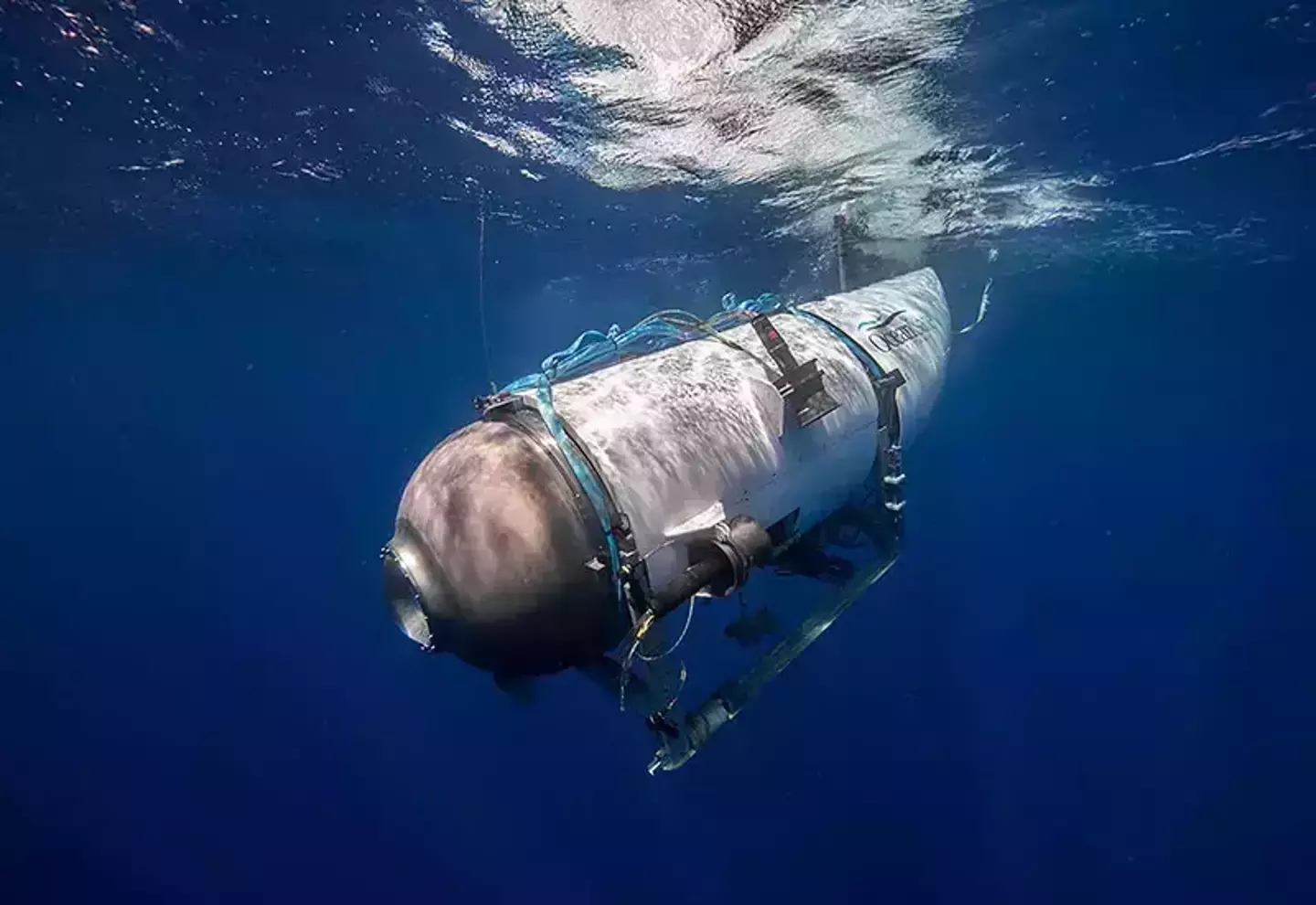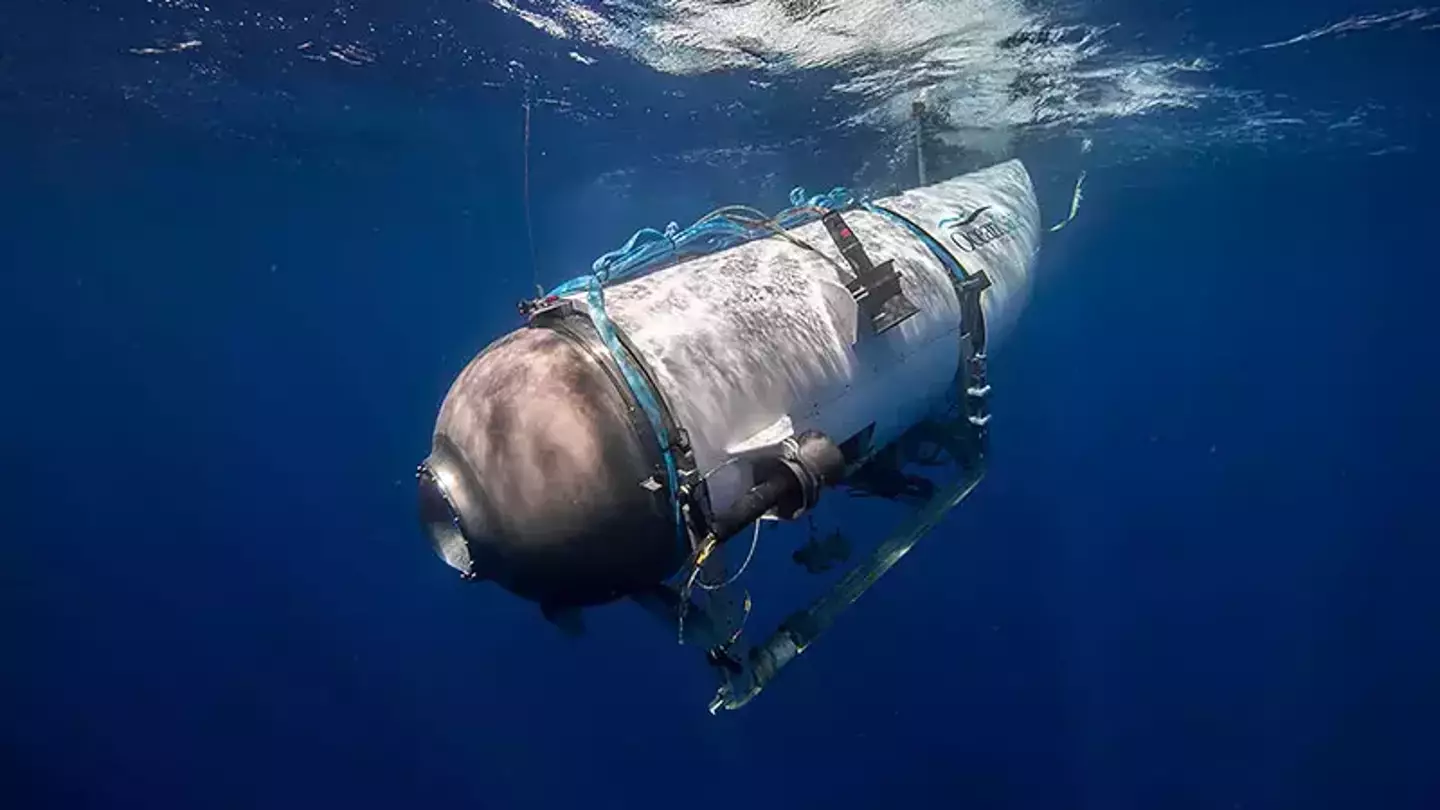
This live has now ended. Follow our latest coverage of the search for the missing vessel here
KEY Points
Experts admit they 'don't know' what is causing noises that could be the OceanGate Titanic submarine
Underwater vehicles redeployed in response to ‘banging noises’
Man who had place booked for Titanic sub trip 'pulled out due to fears corners were being cut'
Less than 24 hours of breathable air left inside missing Titanic sub
Family members of missing Titanic sub passengers say 'sole focus' is their rescue
Plane picks up banging sound near where Titanic submersible vanished
The US Coast Guard has said that people ‘need to have hope’ that the OceanGate Titanic expedition submersible will be found, despite estimates suggesting that there may not be much oxygen left.
In an earlier press conference, Captain Jamie Frederick said that he ‘doesn’t know’ what is causing the noises that have been picked up by a few sonar buoys in the ocean, not far from the last known location of the craft.
Known as Titan, the small submersible has five people on board, British billionaire Hamish Harding, French diver Paul-Henry Nargeolet, OceanGate CEO Stockton Rush, Pakistani businessman Shahzada Dawood and his 19-year-old son Suleman.
The search is currently covering a remote area of the ocean twice the size of the US state of Connecticut, with leaders describing it as ‘complex’ and ‘difficult’.
Frederick told the press: "We don't know what (the noises) are, to be frank with you."
"We're searching in the area where the noises were detected," he then added, insisting that they ‘need to have hope’.
More tools are expected to arrive to assist the search soon.
Read the full story here.
A senior Coast Guard representative in the search and rescue mission admitted that they 'don't know' what is causing the noises that could be coming from the OceanGate Titan submersible lost in the Atlantic Ocean.
Coast Guard Captain Jamie Frederick was joined by a number of key parties in the search and rescue operation at a press conference, telling the gathered press that those in charge remain hopeful of finding the five people on board the sub.
The search area has been widened to an area twice larger than the US state of Connecticut, and several noises – including reports of ‘banging’ – are being investigated by analysts and with remote operated vehicles.
“As a result [of the noises] ROV operations were relocated in an attempted to explore the origin of the noises,” he said.
“Although the ROV searches have yielded negative results they continue."
Frederick said that more ROVs are set to arrive to aid the search in the area where the noise was detected.
Some of those vehicles will have additional capacity to work at greater depths, he added.
breaking news
Missing Titanic sub may have less than 20 hours of oxygen left
The missing OceanGate Titan submarine could have less than 20 hours of oxygen left, based upon initial estimates.
At the time the submersible went missing on the way down to the wreck site of the RMS Titanic, it was estimated that there would have been around 96 hours of oxygen left for the five passengers on board.
The US Coast Guard's Rear Admiral John Mauger, the man leading the search, told BBC News that he believes the missing sub could run out of oxygen tomorrow morning (local time), based on information.
He pointed out the oxygen supply is contingent on consumption, saying: "One of the factors that makes it hard to predict how much oxygen is left is that we do not know the rate of the consumption of oxygen per occupant on the sub."
A huge search and rescue mission is still underway in the North Atlantic after the submersible lost contact with its pilot ship and disappeared.

Since then, ‘banging’ sounds have been heard by buoys dropped by an aeroplane involved in the search, as well some knocking that could be the passengers of the sub attempting to communicate.
Mauger described the mission as ‘complex’ and difficult’ due to the remote nature of the location.
He told BBC News: "This has happened in a remote location, we have prioritised our efforts both on surface and subsurface search.”
He added that they are still investigating the possibility ‘that noise [the banging] is potentially being generated’.
As of yet though, he said that they have no confirmation.
We've picked up noise signatures and we are working through the analytics of that,” the US Coast Guard search leader said.
Titanic submarine passengers' family member speaks out
A family member of Shahzada and Suleman Dawood has spoken out as the mission to find the OceanGate Titan submarine that has been missing for several days continues.
48-year-old Shahzada's sister and 19-year-old Suleman's aunt Sabrina Dawood told Sky News, "We are deeply grateful for the efforts of news agencies during this difficult time; your constant coverage of the missing Titan submersible is undoubtedly playing a large role in the world's ability to access relevant updates on the matter."

"At this time, the Dawood family's sole focus is the rescue of our beloved Shahzada and Suleman Dawood and we are unable to address any questions or comments at the moment.
"We trust that the family will be granted privacy as we deal with this crisis.
"May Shahzada and Suleman return to us safe and sound.
"We are sure they would be as moved as we are by the support of the global community during this period of difficulty."
The two members of the Dawood family are amongst five people aboard the missing submersible, which is somewhere in the North Atlantic, having lost contact with the pilot ship some hours after setting off to the wreck of the RMS Titanic.
Also on board are British billionaire Hamish Harding; French maritime expert Paul-Henri Nargeolet, and OceanGate CEO Stockton Rush.
Both Suleman and Shahzada are British citizens, but the Dawood family is one of the most prominent in Pakistan, owning concerns in agriculture, health, and industry.
Tickets for the OceanGate excursion are reported to have cost up to $250,000 (£195,000) for the eight-day trip which included the submersible trip to the wreck site.
Expert says rescuers may get just ‘one chance’ to rescue those on board missing Titanic submarine
The OceanGate Titan submersible is still missing somewhere in the Atlantic Ocean with five people on board and the supply of oxygen running out.
A huge search and rescue operation is underway to locate the craft and bring those inside back to safety.
However, an expert in naval architecture has warned that – even if the vessel is found – the rescuers might only get one chance to grab it and get those inside it back to the surface.

Fotis Pagoulatos told the Wall Street Journal: "You need a ship that can lower a cable to pull the Titan up or have some kind of a claw.
"Even if they find it, there may not be enough time for the rescue because of the oxygen issue inside.
"Pulling up a vessel the size of a small bus is a complicated operation that takes time, and you only get one chance."
So far, the search has yielded no positive results, but the US Coastguard has ‘detected underwater noises in the search area’.
An aeroplane assisting the search also heard ‘banging’ sounds from the ocean, meaning that hope may yet remain.
Read the full story here.
Video shows the sheer scale of the task facing the search and rescue team
The lost submersible was attempting to visit the wreck of the RMS Titanic, which sits beneath the almost-freezing North Atlantic Ocean.
At 12,500 feet under the sea – some 2.4 miles if you prefer – and around 600 kilometres from Newfoundland in Canada, it’s a pretty remote part of the world that the search and rescue team have been scouring.
However, in the grand scheme of things, the Titanic isn’t at one of the deeper parts of the ocean, and sits at around the average for both the Atlantic and Indian oceans.
Much deeper than that lies a place about which very little is known, at the very bottom of the earth is the Mariana Trench in the Pacific Ocean.
Down there it’s completely dark, the pressure is immense, and there’s very little known about what can survive down there.
In the video above, you can see an illustration of exactly how deep the oceans of the world get, interspersed with some more recognisable landmarks for scale.
Previous OceanGate expedition captured footage of Titanic wreckage
A previous OceanGate submersible expedition to the site of the wreckage of the Titanic captured the first 8K footage of the sunken ship.
Search and rescue efforts to find their Titan submersible are ongoing in an attempt to rescue the five people who were on board the vessel when it went missing.
They had been journeying down to the ocean floor to see the wreckage of the infamous ship Titanic.
OceanGate had previously made a number of expeditions down to the shipwreck and captured clear footage of the Titanic over a century after it hit an iceberg and sunk on the maiden voyage.
Efforts to locate the missing submersible and rescue the five people on board continue and time is of the essence as they are expected to run out of air tomorrow (22 June).
Sonar has picked up a repeated banging noise near the wreck of the Titanic with underwater vessels deployed in the hopes of getting a clearer idea of where the stricken submersible might be.
Read the full story here.
Man who had place booked for Titanic sub trip 'pulled out due to fears corners were being cut'
A man pulled out of taking a trip on the now missing OceanGate submersible after he felt 'less than convinced' about safety.
Search teams are looking for the submersible Titan, which has been missing since 18 June with five people on board, and the air expected to run out by 6am BST tomorrow (22 June).
61-year-old Chris Brown had booked on board the submarine alongside his friend Hamish Harding, one of the five people trapped on the missing submarine, but backed out after becoming 'concerned' about the quality of the vessel.
He said after discovering that OceanGate had used 'old scaffolding poles for ballast' and piloted it with 'computer game-style controllers' he asked for a refund.

Chris eventually told OceanGate 'I'm no longer able to go on this thing.'
Trapped on the missing submarine along with Harding are French maritime expert Paul-Henri Nargeolet; Shahzada Dawood and his son Sulaiman; and OceanGate CEO Stockton Rush.
Read the full story here.
Deep sea expert explains what 'worst case scenario' would be for missing sub
Oceanographer Dr David Gallo told Sky News that the OceanGate submersible Titan could have suffered a 'catastrophic implosion' which would have been the 'worst thing' that could happen to it.
He said it was 'unpleasant to think about' but that he doesn't know 'how else you can disappear that quickly'.
Dr Gallo was wondering what could have caused the sub to lose contact with the surface and go missing.
He has also said the deep sea exploring community 'expected this to happen' at some point because of the difficulties associated with running into a problem deep beneath the sea.

The expert said there was 'no coming back' if the submersible had suffered from a catastrophic implosion.
Rescue efforts continue to search for the missing sub and the five people who were on board at the time it disappeared.
Read the full story here.
breaking news
Sound signals suggests Titanic submarine could be near or at the surface, expert says
A search and rescue expert has suggested the sub could be near or at the surface.
Frank Owen told the BBC: "Firstly, on board this craft is a retired French navy diver. He would know the protocol for trying to alert searching forces... on the hour and the half hour you bang like hell for three minutes.”
Sonar has picked up regular banging noises in the search zone at regular half-hour intervals and this clue could signal that the submersible is either on the surface or not that deep beneath the sea.
Owen explained that below 180 metres a layer is created by the cold water temperature and the signal from sonar 'bounces off' it.
Picking up the signals could be a good sign that the sub is above this level or even possibly have surfaced.
However, even if the submersible was on the ocean surface instead of beneath the waves it would still be difficult to spot.
The OceanGate Titan's small size means that very little of it would actually be above the water even if it had risen to the surface.
Even if they do make it to the surface the submarine passengers will require help to get out, as the vessel's hatch can only be opened from the outside.
Friend of Hamish Harding says opportunity ‘to find them alive’ is being lost
A friend of Hamish Harding, one of the five people missing along with the OceanGate submarine Titan, has said the window of opportunity to find them while they're still alive is being lost.
British billionaire Harding is one of five passengers authorities are searching for along with Paul-Henri Nargeolet; Shahzada Dawood and his son Sulaiman; and OceanGate CEO Stockton Rush.
Jannicke Mikkelsen, a friend of Harding, said she spoke to the missing man 'right before his dive' where he told her they'd be going into the water soon as a 'weather window' had opened up.
She said: "I’m nervous. I’m sick to my stomach with nerves. I’m terrified, I’m anxious. I’m not sleeping at the moment. I’m just hoping for good news. Every single second, every single minute feels like hours."

Mikkelsen said she was concerned that as time passed we were 'losing opportunity to find them alive'.
The submarine has been missing since 18 June and experts estimate the oxygen supply for the five passengers on board will run out tomorrow (22 June).
Read the full story here.
Underwater vehicles redeployed in response to ‘banging noises’
Underwater vehicles which are being used in the search for the missing submersible have been redeployed after 'banging noises' were picked up.
US and Canadian coast guards have put a great deal of effort into the search for the sub but as of yet, they've not been successful in finding it.
Time is of the essence as the submersible has a limited supply of oxygen and it is expected to run out at 6am BST tomorrow (22 June).
While the sub hasn't been found there have been potential clues which the search and rescue operations are investigating.
The US coast guard recently confirmed that a Canadian P-3 aircraft detected 'underwater noises in the search area' and two search crews have picked up 'banging noises' not far from where the submersible went missing.
A government memo from the Department of Homeland Security said sonar had been detecting regular banging noises every 30 minutes and could still be heard at regular intervals hours later.
Remote underwater vehicles were redeployed in response to the banging noises and while they have not yet found anything the search efforts continue.
It is hoped that the regular banging noises are the submersible's passengers sending out a distress message to be picked up by sonar detection tools.
Read the full story here.
Oceanographer Dr David Gallo says community ‘knew this was going to happen at some point'
An oceanographer and deep sea explorer has said the community ‘expected this to happen’ at some point, but that he’s still ‘stunned’ after the OceanGate submersible went missing at the weekend.
Oceanographer Dr David Gallo told Sky News that those in the deep sea exploration industry knew 'darn well' an emergency like this would take place, saying he feels 'frustrated'.
He told the news outlet: "Anyone in the exploration business of the deep sea expected this to happen, not at this particular time, but we knew this was going to happen at some point.
"We knew darn well it would and we knew all the difficulties around how you recover from it if the sub is stuck on a shipwreck, if they lose batteries and nothing was done about it, there's no policies, there's no plan.

"It just frustrates me. Now begins the scramble to try and get the right things at the right place at the right time and it's just an unnecessary step because we did know at some point this was going to happen and I think all of us in the community are stunned.
"It wasn't a surprise in a way, but oh my God it really did happen."
Read the full story here.
Plane picks up banging sound near where Titanic submersible vanished, leaked emails reveal
Two separate search crews have reported hearing banging and tapping sounds coming from a location not far from where the tourist submarine went missing as it ventured towards the wreckage of the Titanic.
According to several leaked emails seen by Rolling Stone, a Canadian aircraft fitted with sonar technology has picked up repeated banging sounds.
The publication claims it has seen reports of repeated noises as per an email exchange by the US Department of Homeland Security.
"RCC Halifax launched a P8, Poseidon, which has underwater detection capabilities from the air reported a contact in a position close to the distress position," the email claimed.

"The P8 heard banging sounds in the area every 30 minutes. Four hours later additional sonar was deployed and banging was still heard."
Additionally, the email claimed that 'the Joint Rescue Coordination Centre is working to find an underwater remote-operated vehicle through partner organisations to possibly assist' in determining the source of the noise.
But they weren't the only ones picking up noises not far from the last known location of the missing submersible.
Travel and research group, the Explorers Society, also claimed their crew heard a 'tapping' noise in another email, also seen by Rolling Stone.
"It is being reported that at 2 am. local time on site that sonar detected potential ‘tapping sounds’ at the location, implying crew may be alive and signalling," the leaked email read.
Read the full story here.
Missing Titanic submarine passengers are locked in from the outside with 'no way to escape'
The crew on board the missing Titanic submersible have no way of getting out, a former passenger has said.
Last year, a separate crew also became lost during an expedition, including Shrenik Baldota and CBS reporter David Pogue.
Speaking about the scary ordeal on Twitter this week, Pogue warned that the crew is completely locked inside and is unable to get out.
Explaining the set-up during his report back in November, Pogue said: "The crew closes the hatch, from the outside, with 17 bolts. There's no other way out.
"So unless they are found and let out of the vessel manually, they will die."
"There's no way to escape, even if you rise to the surface by yourself," he told the BBC. "You cannot get out of the sub without a crew on the outside letting you out.
“There’s no backup, there’s no escape pod - it’s get to the surface or die."
Read the full story here.
Former passenger of lost Titanic sub says it vanished for hours last summer
A passenger who had previously boarded the missing Titanic submersible says his crew also got lost during a separate expedition last summer.
One of the people on board was CBS reporter David Pogue, who has taken to Twitter to speak about his experience in light of the current emergency.
He said: “You may remember that the @OceanGateExped sub to the #Titanic got lost for a few hours LAST summer, too, when I was aboard."

When asked on 19 June about the current crew's chances of survival, Pogue said it was possible.
"Communication with the sub is lost... AND they don’t know where it is," he said.
"Yes, they could still be OK. They have four days of oxygen, and seven ways to rise to the surface. The question is, why HAVEN’T they?"
Also speaking abut the trip in Pogue's CBS report, passenger Shrenik Baldota said: "We were lost. We were lost for two-and-a-half hours."
Read the full story here.
Less than 24 hours of breathable air left inside missing Titanic sub
In an update on the search and rescue mission last night, the US Coast Guard confirmed that 'to date, search efforts have not yielded any results'.
Speaking about the operation, Captain Jamie Frederick, of the First Coast Guard District, said it was 'complex' and 'requires multiple agencies'.
He explained that the Titan vessel had just 40 hours of oxygen left - at the time of the press conference - for the five passengers, with the sub able to remain underwater for 96 hours.
It is believed the breathable air is due to run out at 11am BST on Thursday, 22 June.
Since the rescue mission began, the Coast Guard and other services have been searching an incredible '7,600 square miles, an area larger than state of Connecticut'.
On board are five crew members: British billionaire Hamish Harding; Shahzada Dawood and his son Sulaiman; French maritime expert Paul-Henri Nargeolet; and OceanGate CEO Stockton Rush.
Read the full story here.
Showing 17 of 17
updates to this article
Topics: World News, Titanic